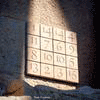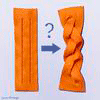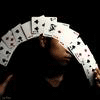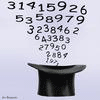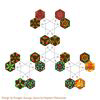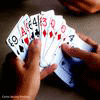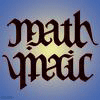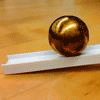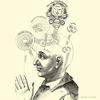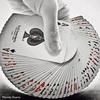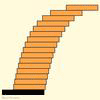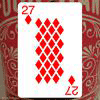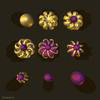Mathematics Awareness Month 2014: Mathematics, Magic, and Mystery
Navigate the Calendar
A Few Little Fibs
“Magicians often lie, to gain your confidence and distract you from what they are really up to. Mathemagicians would never dream of doing that, of course. At worst, we might sneak in a few little fibs.” So says longtime MAA columnist and Spelman College professor Colm Mulcahy, inventor of this impressive magical effect. See if you can catch the hidden meaning in his words as he performs the Little Fibs trick.
Here is computer scientist, magician, and puzzle collector Christopher Morgan to explain the effect.
Colm Mulcahy explains the trick here (and he includes an explanation of how he managed to shuffle the deck before performing the trick).
Taking it Further
The Fibonacci Sequence is at work behind the scenes here. The one crucial property that makes the trick work is the fact that the sum reported by the two spectators completely determines the two individual cards. Your first challenge is a simple one: Verify this. The sum of any two cards from the set
must be a number between 3 (= 1 + 2) and 21 (= 13 + 8). By checking the possibilities, verify that each attainable sum can only arise one way. For instance, 10 = 8 + 2, and no other pair of cards will sum to 10.
Note that in his performance above, Colm lets his volunteers decide whether he should use all six cards, or just four or five of them. This does not affect the working of the trick. Rather, it just eliminates a few of the sum values that might otherwise be possible. Keep in mind that when you perform the trick, the suits of the six cards are irrelevant, but the specific cards used must be memorized.
As a second challenge, answer this: Can this trick be modified to work with three volunteers, rather than two? That is, does a sum of three of the six cards uniquely determine the three cards?
A seemingly different, but closely related application of the Fibonacci numbers arises in this fun variant of the game of Nim: The game begins with a stack of objects, say coins or poker chips, and two players, A and B. Player B decides how many chips will be placed in the stack initially, let’s say there are n. Player A then removes some chips; he may remove any number from 1 to n – 1. From this point on, the players alternate turns. On each turn a player may remove any number of chips, from 1 to twice the number removed in the previous turn. The player who removes the last chip from the stack wins.
It so happens that Player A can always win, but he has to play precisely the right strategy to do so. There is a simple online simulation here where you get to be Player A. Can you figure out the winning strategy? If you’re not sure, try fibbing your way out!
For those who want to explore the Fibonacci sequence for the pure pleasure of it, we invite you to investigate what happens when you divide every number in the sequence by a fixed number, say 7, and write down the remainder. For those in know, this is called “reducing the Fibonacci sequence modulo 7.” The sequence of remainders has some lovely properties. You can learn about them here.
The Underlying Mathematics
The Fibonacci sequence begins 1, 1, 2, 3, 5, 8, 13, and is defined by the property that starting with the third term, each number in the sequence is the sum of the two numbers preceding it. We will denote the nth term of the sequence by Fn.
In 1939, Edouard Zeckendorf, an amateur mathematician and doctor in the Belgian army, observed that every positive whole number can be uniquely expressed as a sum of distinct, nonadjacent Fibonacci numbers. For example, the representation of 2014 is
This important decomposition is known as the Zeckendorf representation of a number. More applications of the principle to card magic can be found in the February 2008 Card Colm titled “Additional Certainties.”
The Little Fibs trick relies on a simpler version of the Zeckendorf decomposition: A sum of two Fibonacci numbers can be decomposed in only one way. That is, it can never be the case that
if m, n, r, and s are all distinct. The proof is simple: Suppose to the contrary that there are four distinct Fibonacci numbers that satisfy the equation above. Then one of them is the largest; say it is Fr. From this it follows from the definition of the Fibonacci numbers that Fm + Fn ≤ Fr, and we are forced to conclude that Fm + Fn < Fr + Fs.
Colm Mulcahy’s Mathematical Card Magic: Fifty-Two New Effects, (CRC Press, 2013) describes the Little Fibs trick, the underlying principles, and several related effects. See chapter 4, “More Additional Certainties.”
There is a wealth of information available on the remarkable properties of the Fibonacci numbers and related mathematical ideas. An excellent starting point is Martin Gardner’s Mathematical Circus (Vintage Books, 1979), currently available as part of the CD compilation Martin Gardner’s Mathematical Games: The Entire Collection of His Scientific American Columns on one CD (MAA, 2008). See Chapter 13, “Fibonacci and Lucas Numbers.”
A more sophisticated but still accessible reference for Fibonacci number facts is Graham, Knuth, and Patashnik’s Concrete Mathematics: A Foundation for Computer Science (2nd ed., Addison-Wesley, 1994). See chapter 6.6.
Are you a fan of all things Fibonacci? Then you should keep an eye out for the Fibonacci Association and the events and conferences they sponsor. For example, they publish The Fibonacci Quarterly, a journal dedicated to mathematics related to the Fibonacci sequence. The journal has been in print since 1963, and back issues up to 2003 may be downloaded for free!
Connected Classroom
See the Google Plus Hangout with Colm, Connected Classrooms: Mathematical Magic with Cards, created by the MAA, which aired live on April 8.



